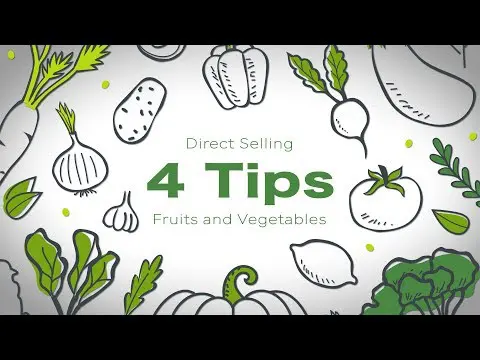Selling fruits and vegetables online is an increasingly popular way to reach a wider market. With the rise of eCommerce platforms, it’s now easier than ever for farmers and producers to set up their own online store and start selling their produce directly to customers. In this guide, we’ll take you through the steps of setting up an online store for fruits and vegetables, from understanding the market to creating your shop front. We’ll also provide tips on how to make sure your store stands out from the competition. So if you’re ready to get started, let’s dive in and learn how to sell fruits and vegetables online!To prepare fruits and vegetables for selling online, first, select the freshest produce available. Make sure to inspect each piece for any signs of decay or damage. Next, wash all fruits and vegetables thoroughly under cold running water. If necessary, use a vegetable brush to remove any dirt or debris from the produce surfaces. After washing, pat dry with a clean paper towel or cloth napkin. Then, sort the produce into separate piles based on size, condition, and color. Once sorted, prepare the produce for packaging by trimming off any damaged parts or wilted leaves from the fruits and vegetables. Finally, package the produce in sealed containers that are labeled with the type of fruit/vegetable and weight/volume of contents.
Equipment for Selling Fruits and Vegetables Online
Starting a business selling fruits and vegetables online requires a few pieces of essential equipment. To ensure your business runs smoothly, you need the right tools for the job. Here are some of the most important pieces of equipment you will need to sell fruits and vegetables online:
Packaging Equipment
When selling fruits and vegetables online, you’ll need to package them carefully to ensure they arrive at their destination in good condition. You’ll need boxes or bags that are designed to protect produce from damage during shipping, as well as tape, labels, and other materials for packaging. If you plan on shipping perishable items like produce, you’ll also need thermal packaging materials such as insulated boxes and ice packs.
Weighing Scale
A weighing scale is an essential piece of equipment for any business selling produce online. You’ll need to weigh each item accurately so customers know exactly how much they’re getting. Invest in a digital scale that can accurately measure small weights in increments of one gram or less. This will ensure that customers get the exact quantity they’re expecting when they order from your store.
Refrigeration Equipment
If you plan on selling perishable items like fruits and vegetables, you’ll need refrigeration equipment to keep them fresh until they are purchased by customers. Invest in a commercial grade refrigerator or freezer with sufficient capacity for your needs. Make sure it is energy efficient so that it doesn’t cost too much to run.
Inventory Management System
An inventory management system is also essential when selling produce online. This will help you keep track of all your stock levels so that you can quickly restock items when needed and prevent overstocking or running out of popular items unexpectedly. Look for a system that is easy to use and integrates seamlessly with your e-commerce platform so that it’s easy to manage your inventory from one location.
Positive Temperature Coefficient Heaters
Positive temperature coefficient (PTC) heaters can help keep your products at the optimal temperature level during storage or transit. These heaters use electrical current to generate heat, which helps maintain consistent temperatures even when surrounding temperatures fluctuate significantly. Investing in PTC heaters could be beneficial if you want to ensure that all your produce arrives in perfect condition every time it’s shipped out from your store.
Where Can You Sell Fruits and Vegetables Online?
With the increasing demand for fresh produce, many entrepreneurs are now looking to sell fruits and vegetables online. Selling fresh produce online has become a popular way to reach new customers, increase sales, and even make a profit. It can be a great way to supplement your existing business or start a new one entirely.
However, before you can start selling fruits and vegetables online, you need to know where to do it. There are several different places that you can sell your produce online, including marketplaces, e-commerce websites, and even social media platforms.
The most popular place to sell fruits and vegetables online is an online marketplace such as Amazon or eBay. These marketplaces provide sellers with access to millions of potential customers all over the world. They also make it easy for buyers to search for specific items they are looking for. Additionally, many marketplaces offer low fees and quick payment processing times for sellers.
Another option for selling fruits and vegetables online is an e-commerce website like Shopify or BigCommerce. These websites provide sellers with their own storefronts where they can list their products and manage their orders easily. They also offer features such as SEO optimization, marketing tools, analytics tracking, and more that make it easier for sellers to promote their products and increase sales.
Finally, many entrepreneurs are now using social media platforms such as Instagram or Facebook Marketplace to sell fruits and vegetables online. These platforms allow sellers to reach their target audience quickly and easily while also offering features like product tagging that make it easy for customers to find what they’re looking for quickly. Additionally, some of these platforms have built-in payment systems which make it easy for buyers to pay quickly without leaving the app or website they’re on.
No matter which platform you choose, selling fruits and vegetables online can be a great way to increase your profits while providing customers with fresh produce that they can trust. With some research into the different options available, you should be able to find the best platform for your business needs in no time!
Pricing Fruits and Vegetables When Selling Online
Pricing is an important factor when selling fruits and vegetables online. It is essential to get the pricing right, as it will determine how profitable your business will be. In this article, we will discuss the best practices for pricing fruits and vegetables when selling online.
The first step is to determine what kind of pricing strategy you will use. The most common strategies are market-based pricing or cost-plus pricing. Market-based pricing means you set the price based on what similar items are being sold for in the market. Cost-plus pricing means you set the price based on your cost plus a markup.
Once you have chosen a pricing strategy, you can begin researching what other online sellers are charging for similar items. This can give you an idea of what prices customers expect to pay. You should also consider the cost of shipping when setting your prices, as this can have an impact on how much customers are willing to pay for your products.
You should also consider any discounts or promotions that you can offer customers to encourage sales. For example, offering free shipping or discounts on bulk orders may be beneficial if you want to increase sales volume. Additionally, offering loyalty rewards or discounts for repeat customers may help build customer loyalty and increase sales over time.
Finally, it is important to monitor your competition’s prices and adjust yours accordingly if needed. This will ensure that your prices remain competitive and that customers continue to purchase from you rather than your competitors.
Overall, setting the right price for your fruits and vegetables when selling online is essential for success in this competitive market. By using market-based or cost-plus pricing strategies, researching competitor’s prices, offering discounts or promotions, and monitoring competition’s prices regularly, you can ensure that your business remains profitable while providing customers with quality products at fair prices.
Writing Descriptions of Fruits and Vegetables When Selling Online
When selling fruits and vegetables online, it is important to create effective descriptions that capture the attention of potential buyers. While it may seem like a daunting task, there are some simple tips you can follow to ensure your descriptions are effective and engaging.
First, make sure to provide detailed information about each item you are selling. Include the type of produce, its size, and its freshness. If possible, include pictures of the product that accurately show off its quality and appearance. This will help customers determine the quality of the item before they purchase it.
Next, focus on describing the flavor and aroma of the produce in your description. Use words like sweet, tangy, or savory to help customers imagine what the flavor of the fruit or vegetable will be like. Give them an idea of how it will taste in recipes or by itself so they can get an accurate impression.
Finally, highlight any health benefits associated with each type of produce you are selling. For example, if you have apples available for sale, mention that they have high levels of antioxidants or fiber that make them a great choice for health-conscious people. This will give potential buyers another incentive to buy from you.
By following these tips when writing descriptions for fruits and vegetables online, you can encourage more customers to make purchases from your store. This will help increase sales and boost your profits over time!

Packaging Options for Shipping Fruits and Vegetables Online
Shipping fruits and vegetables requires careful consideration of the packaging materials used. To ensure that products arrive intact, it is important to select packaging options that are designed specifically for shipping fruits and vegetables online. These packaging materials should be lightweight, durable, and capable of protecting the produce from damage caused by moisture, temperature changes, or other environmental hazards.
One option for shipping fruits and vegetables is cardboard boxes. Corrugated cardboard boxes are lightweight yet strong enough to protect the contents during transport. They also have an additional layer of fluting which provides a buffer between the box and its contents. Furthermore, these boxes can be easily customized with printing or labels to add branding or product information.
Another option for shipping fruits and vegetables is foam packaging material. This type of packaging material is lightweight yet strong enough to provide ample protection for your products during transit. Additionally, foam packaging can be cut into various shapes and sizes to accommodate different types of items being shipped, such as produce bags or produce trays.
Finally, insulated foam coolers are a great option when shipping perishable items like fruits and vegetables online. These coolers feature an insulated lining that helps maintain proper temperatures during transport while also preventing moisture from entering the package. The insulated lining also provides an extra layer of protection from shocks or drops that could otherwise cause damage to fragile items like produce bags or trays.
Overall, there are a variety of packaging options available for shipping fruits and vegetables online. Careful selection of these materials will ensure that your products arrive undamaged at their destination while also providing additional branding opportunities through printing or labels on the packages themselves.
Creating an Engaging Website
Creating a website for your online store is key to success. Designing an attractive and user-friendly website is essential to attracting customers. Make sure you feature photos of your produce prominently and add descriptions that will help customers learn more about the fruits and vegetables they are buying. Also, make sure your website is easy to navigate and includes a shopping cart that allows customers to place orders quickly and securely.
Using Social Media
Social media can be a great way to promote your online store. Posting photos of your produce on platforms such as Instagram, Facebook, and Twitter helps create brand awareness and encourages people to visit your store. You can also use social media to communicate with customers directly, answer questions, provide updates on new products or promotions, and build relationships with potential customers.
Advertising
Advertising can be a great way to reach potential customers who may not otherwise know about your business. Consider placing ads in local newspapers or magazines that target the demographic you are looking for. You can also use online advertising platforms such as Google Ads or Facebook Ads to reach more people in specific geographical areas or with certain interests related to fruits and vegetables.
Building Partnerships
Building partnerships with local businesses can be a great way to get people interested in your store. Consider partnering up with restaurants, grocery stores, or other stores that sell fruits and vegetables so that you can refer each other’s customers for mutual benefit. You could even offer discounts or coupons for customers who purchase from both stores simultaneously.
Word of Mouth
Word of mouth is one of the most powerful forms of marketing and it’s free! Ask satisfied customers if they would be willing to share their experiences with others by writing reviews online or simply telling their friends about your store. You could also offer incentives such as discounts or gift cards for referring new customers which could help drive more sales in the long run.
Legal Requirements When Selling Fruits and Vegetables Online
When selling fruits and vegetables online, it is important to understand the regulations and legal requirements that may apply. Depending on the type of business, there may be different laws and regulations in place to protect consumers from mislabeling or contamination. Understanding these laws can help ensure that your business is running legally and safely.
The first step in understanding the legal requirements when selling fruits and vegetables online is to check with your local government for any applicable laws or regulations. Many countries have specific labeling and packaging requirements for food products sold online, as well as restrictions on the types of ingredients that can be used in products. Additionally, there may be specific rules regarding storage temperatures, sanitation standards, or other safety protocols that must be followed.
In addition to local government regulations, businesses must also comply with any applicable federal laws for food safety. The U.S. Food and Drug Administration (FDA) requires all food products sold online to include an ingredient list, a nutrition facts label, and allergen warnings if applicable. Additionally, businesses must comply with FDA regulations regarding advertising practices such as truth in advertising standards or labeling claims about health benefits of a product.
Finally, businesses should consider any additional safety protocols they may want to put in place beyond what is required by law. For example, it may be beneficial to use third-party testing services to ensure that all produce meets safety standards before it is sold online. Additionally, businesses should consider developing a recall plan in case an issue arises during the sale of their product.
By taking the time to understand the legal requirements when selling fruits and vegetables online and implementing additional safety protocols where necessary, businesses can ensure that they are operating legally while providing consumers with safe products they can trust.

Conclusion
Selling fruits and vegetables online can be a great way to increase your customer base and ensure that your produce is accessible to more people. By taking the time to understand the process, you can maximize the potential of your online store. Utilizing customer feedback and analytics, you can develop an effective marketing strategy that will help you reach new customers while also retaining current ones. Additionally, developing strong relationships with other businesses in the industry can help ensure that you are always able to supply your customers with quality produce. By following these tips, you can have a successful business selling fruits and vegetables online with ease.
Regardless of which platform or method you choose, it’s important to remember that selling fruits and vegetables online takes time and dedication. It’s not enough to simply set up a store and hope for the best — it takes hard work, dedication, and patience to build a successful online business. However, if done correctly, selling fruits and vegetables online can be incredibly rewarding for both your business and customers alike.



